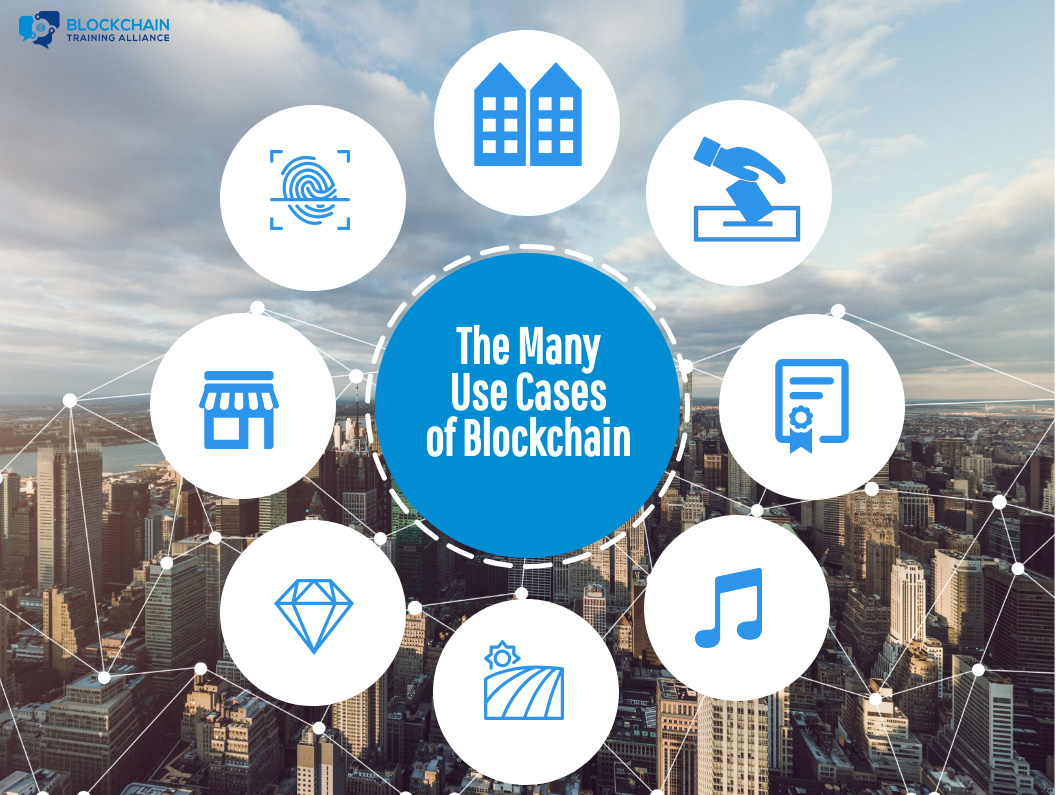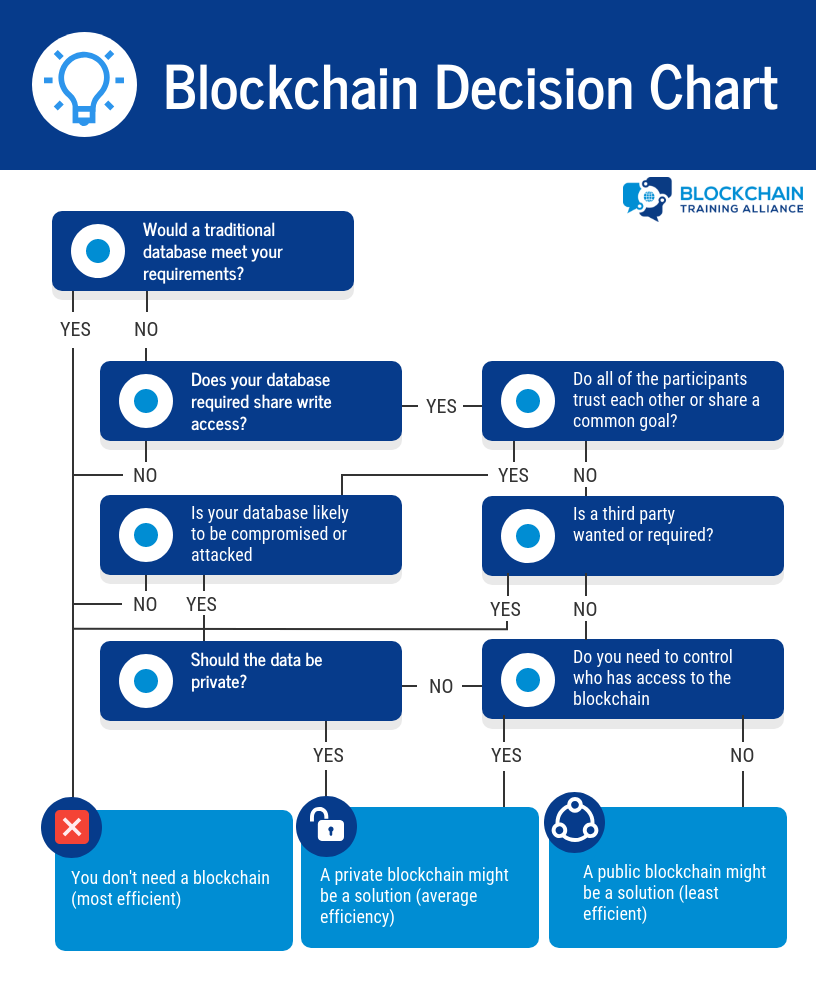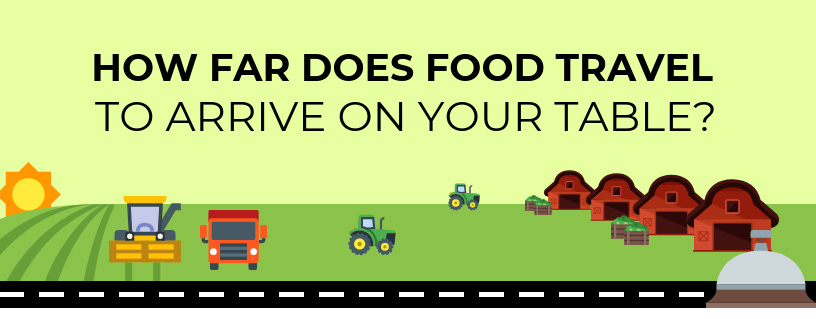This course is from edX
Scroll down click “Read More” to check original post on edX.
Syllabus
Welcome & Introduction
Chapter 1. Introduction to Blockchain
This section covers some of the technical aspects that comprise a blockchain and explain why blockchain is different and “works” in comparison with technologies of the past.
Chapter 2. Governance and Consensus
This section covers the various methods of blockchain governance that currently exist in the marketplace as well as how consensus fits into governance. It also covers various levels of governance and how it works with both public and permissioned blockchains.
Chapter 3. Blockchain Problem Solving
This section takes a look at the very specific features of blockchain that solve problems that have been difficult to solve in the past with more centralized architectures.
Chapter 4. Blockchain Use Cases
This section covers various use cases of blockchain. It examines the problem, and then depicts a blockchain use case that solves the problem.
Final Exam
Summary from Last Chapter (Chapter 3)
Blockchain is an immutable ledger. Once a block has been added to the chain, the data in the block is permanent and cannot be altered or deleted.
This append-only ledger needs a way to verify valid transactions and delete invalid transactions before a block is added to the chain.
Transactions cannot be validated and added chronologically, because that would allow for a double spend attack. Double spending occurs when an address rapidly initiates two transactions. One of these transactions could be invalid, but, because they are initiated at the same time, both transactions could be approved. To solve this, transactions are put into a pool of unverified transactions, then nodes add these unverified transactions to a block.
When a block is full, consensus occurs, which is a process that selects the owner of a new block to be added to the chain. When consensus is achieved, nodes then validate each transaction in the selected block by referencing transactions associated with an address.
Transactions can also be added in the form of smart contracts. Smart contracts are business logic in the form of self-executing code that lives on the blockchain.
Check other chapters if you finish this chapter.
Chapter 4. Blockchain Use Cases
Chapter 4: Learning Objectives
By the end of this chapter, you should be able to:
- Discuss when blockchain is a suitable alternative to a traditional database.
- Analyze examples of good and bad blockchain use cases.
- Analyze blockchain use cases: healthcare, voting, identity management, land records and government, supply chain, IoT, energy.
- Discuss about the potential of blockchain.
Blockchain Use Cases
Learning Outcomes
By the end of this section, you should be able to:
- Summarize the industries being changed by blockchain.
- Explain when blockchain is a suitable alternative to a traditional database.
- Analyze examples of good and bad blockchain use cases.
Introduction to Use Cases
We are already seeing blockchain disrupt many industries, including: healthcare, automotive, identity, government, real estate and insurance.
In this chapter, we will hear from those who are leading these projects. Companies including IBM, Luxoft, and counties such as Cook County, Illinois (USA), are using blockchain to solve problems, save money, and change the way data is stored and exchanged.

Video: Blockchain Is Like Hot Sauce
Blockchain Decision Chart

Video: Campaign Finance
Video: Unintended Use Cases
Video: Law Enforcement
Video: Music Industry
Healthcare
Learning Outcomes
By the end of this section, you should be able to:
- Explain how MedChain is using blockchain to store medical records.
- Explain how Blockchain can be used to prevent counterfeit drugs.
Video: MedChain Use Case
MedChain Use Case
Video: Blockchain to Prevent Counterfeit Drugs
Blockchain to Prevent Counterfeit Drugs
Voting
Learning Outcomes
By the end of this section, you should be able to:
- Explain whow blockchain can benefit digital voting applications.
- Understand how Luxoft is using blockchain to create a decentralized voting application.
How Blockchain Can Benefit Voting?
Blockchain can be utilized in many different fields as a solution to the problems that a standard database might have. One such problem can be seen in voting. Recently, it was revealed that a major U.S. voting machine manufacturer had installed remote access software on some systems. This software allowed for the alteration of votes when counting the total.
Instances like this create a lack of trust in America’s voting system, as seen in a recent poll: “Exclusive poll: Majority expects foreign meddling in midterms“. This poll suggests that only about a quarter of Americans feel confident that their vote is being counted. Blockchain would solve this issue by providing a distributed ledger that would ensure your vote is counted since the ledger you own is the same as the one counting the total.
Video: Luxoft
Luxoft
Video: Luxoft Voting Application
Identity Management
Learning Outcomes
By the end of this section, you should be able to:
- Explain how LifeID is using blockchain to create an ID for everything in your life.
- Discuss the benefits of LifeID.
- Explain how LifeID works.
Video: LifeID – Self-Sovereign Identity
LifeID – Self-Sovereign Identity
Video: LifeID
Video: LifeID
Land Records and Government
Learning Outcomes
By the end of this section, you should be able to:
- Learn how Cook County, Illinois (USA) is using blockchain to record land titles and show ownership.
Video: Cook County, IL, Recorders Office
Blockchain with Supply Chain
Learning Outcomes
By the end of this section, you should be able to:
- Describe how blockchain is enabling supply chain more than ever before.
- Provide examples of companies planning on using supply chain to provide an extra level of transparency to consumers.
Video: Supply Chain – Maersk
Video: Supply Chain – Maersk
Farm to Table
Farms are complicated ecosystems with many moving parts, careful timing, and seasonal financing structures. However, after the food leaves a farm, it becomes part of a wide-reaching supply chain with a lot of parties. Buyers, sellers, distributors, and grocery chains all want to know where the food is along its journey. You also probably want to know where your food has been before you serve it on your dinner table.

The trend toward blockchain agriculture promises to make each step of growing and distributing food simpler. It will offer all parties involved a single source of truth for the agriculture supply chain. In this article, we will cover four key ways that blockchain is changing agriculture.
Walmart and IBM dive deeper in their use case as we will review on the next page.
Video: Walmart
Video: Walmart
Internet of Things (IoT)
Learning Outcomes
By the end of this section, you should be able to:
- Understand what IoT is.
- Discuss the current problems with IoT.
- Analyze how blockchain can be used to solve these problems.
Internet of Things Explained
Imagine you are sitting on your couch watching your favorite reality show or sports team on your smart TV. During a commercial break, an ad for Papa John’s latest culinary creation catches your attention as your stomach reminds you at the same time that you haven’t had dinner yet. So with a click of the remote, you select the items that you’d like to try and an order is queued in your mobile app that will communicate the details of your order, apply a coupon deal, and share your delivery address. However, a quick internal scan by your smart refrigerator reveals there are still some leftovers from the last time you ate out. Alexa alerts you before your order goes through and gives you an opportunity to cancel it. You decide to follow through with the order anyways, because after all, that old pizza doesn’t have stuffed crust inside of the already-stuffed crust.
Within a half hour, you receive a notification on your TV that the delivery driver is three minutes away and your front door lights automatically turn on in anticipation. In a matter of minutes, the doorbell rings and your show pauses. As you approach the door to greet the delivery driver, it unlocks. After you enjoy your dinner and finish your show, your biometric wristband coordinates with your phone’s health app to analyze your dietary and exercise trends over the past week. Within seconds, a step count goal for tomorrow is set and several healthy options for your next meal are suggested in accordance with the contents of your fridge. This scenario is not far from being a reality, and smart homes with this degree of connectivity are only the beginning of the new technology paradigm in our immediate future.
The potential applications for IoT devices are practically endless, and they encompass industrial and enterprise-level applications in addition to consumer applications. From companies to cities to countries, the opportunity to leverage IoT technology and the data it generates is massive. Businesses can enable dynamic supply chains responsive to consumer demand, cities can minimize energy consumption and traffic congestion, and countries can operate on highly efficient transportation grids and national security networks. However, there are two significant concerns currently inhibiting Internet of Things adoption, security and scalability.
In terms of security, IoT devices and the networks they are plugged into can be susceptible to cyberattacks, putting private or personal data at risk. Many IoT devices are designed to operate on low power networks, utilizing only the essential components for connecting while excluding the computing power necessary to run custom cybersecurity protocols. That being said, a breach in a single device could compromise an entire network, rendering vast amounts of confidential information vulnerable to attack. Additionally, the majority of IoT networks operate on centralized cloud solutions, both for storage and processing purposes. This type of centralized architecture leaves a network exposed to cyber threats and also limits a network’s ability to share and process information. As the global IoT network expands to billions of new devices over the next few years, the sheer amount of data generated will overwhelm our current IT infrastructure, restricting much of the value IoT networks create.
In recent years, another revolutionary type of technology has emerged that could very well be the solution for alleviating the primary pain points facing IoT technology, that technology is blockchain. Blockchain is a challenging topic to assign an all-encompassing definition to due to the extensive nature of the concepts and implementations that fall underneath its umbrella. As a matter of fact, the term “blockchain” today is not unlike the term “internet” in the late 1990’s and early 2000’s, in that it comprises a plethora of ideas, components, and applications all headed in unique directions. However, blockchain can be generally defined as a decentralized network where participants are granted certain rights to exchange, examine, and manage information or value securely with other members of the network. In addition to these rights, each node is responsible for working with all of the other nodes to confirm and keep an undisputed archive of all information made available throughout the network, which is also distributed amongst all the members.
Blockchain could help address many of the security concerns faced by IoT networks. Cryptographically encoded communication channels would permit devices to speak and exchange data with one another securely, and Byzantine Fault Tolerant algorithms would identify threatening devices and prevent them from incapacitating the rest of the network. Permissions could also be granted to each IoT device, determining which nodes would be able to submit data, communicate with other nodes, and view the ledger within the network. So things that might be more susceptible to attack can be assigned write-only permissions, and the rest of the network would monitor these devices and verify that the data they are contributing is valid. Additionally, processing power is allotted to each participant in the network rather than being owned entirely by a central authority, improving latency and facilitating scalability within the network. By allocating resources and responsibilities democratically among network participants, an IoT network powered by blockchain could operate on a highly-efficient and scalable model. Dynamic interactions between devices could optimize end value and enable real-time, data-based decision making. Together, these two technology megatrends are very well suited to complement one another and their union will usher us into a new era of connectivity and utility.
Let’s review the smart home scenario from earlier and see a few examples of how an IoT network built on a blockchain framework could interoperate and harmonize. To begin, every smart device from your TV to your wristband would be able to connect and communicate securely within the blockchain network, ensuring absolute privacy of your personal data. This way your fridge can talk to your phone which talks to your smart lights and so on in a safe and efficient fashion. A blockchain network could also support payments, allowing an app on your phone to automatically pay for your pizza or other goods and services with digital currencies designed for highly efficient and inexpensive value transfer over the internet. Additionally, tasks like re-ordering household essentials or scheduling routine home maintenance could be automated by leveraging the data made available by assorted devices. The technical term for self-executing transactions like these is a “smart contract”, which is a piece of code built on top of the distributed ledger (or data) layer programmed to execute a specific task once certain data inputs are met. For example, you could create a smart contract that re-orders coffee beans when it’s been 30 days since you bought your last bag or your annual AC inspection could be automatically scheduled with a preferred technician in accordance with your calendar’s availability. This opportunity for automation also sets blockchain apart as a superior solution to alternative IoT network structures, like edge computing within cloud-based systems. The smart contract layer built on top of the data and communication layers unlocks an unbelievable amount of potential for an IoT network, especially those with industrial or commercial focus.
Luxoft plans to implement blockchain to keep the IoT secure.
Video: Luxoft IoT Explained
Energy
Learning Outcomes
By the end of this section, you should be able to:
- Explain how blockchain is changing the energy industry.
Video: The Digital Energy of the Future
The Digital Energy of the Future
Future of Blockchain
Learning Outcomes
By the end of this section, you should be able to:
- Discuss about some future industries that blockchain might disrupt.
- Describe the potential of blockchain technology.
Video: Future of Blockchain?
Summary
Chapter 4: Summary
Blockchain is already being used in many industries.
We looked organizations taking advantage of blockchain:
- Luxoft is using blockchain for a decentralized voting application that ensures every vote is counted. They are also using blockchain to make the Internet of Things more secure than it has ever been, to change how automotive ownership works, etc.
- IBM is using blockchain in supply chain to do things like preventing counterfeit drugs in Africa, or to allow consumers to feel more confident when selecting produce. These are just a few applications IBM has used blockchain for.
- LifeID is using blockchain for a universal account associated with your identity.
- Cook County, Illinois (USA), is using blockchain to keep land records more secure than ever before.
- MedChain is using blockchain to change the way that medical records are kept, making it more secure and universal than it has ever been before.
Video: Future of Blockchain?
Blockchain: Understanding Its Uses and Implications – Chapter 4. Blockchain Use Cases
Blockchain: Understanding Its Uses and Implications – Chapter 3. Blockchain Problem Solving
Blockchain: Understanding Its Uses and Implications – Chapter 2. Governance and Consensus
Blockchain: Understanding Its Uses and Implications – Chapter 1. Introduction to Blockchain
[miniorange_social_sharing]
